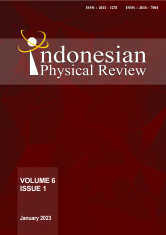APPLICATION OF SUPPORT VECTOR MACHINE ON DROUGHT CODE CLASSIFICATION IN NORTH SUMATRA INDONESIA
DOI:
10.29303/ipr.v6i1.196Downloads
Abstract
This study aims to classify the Drought Code in North Sumatra. Drought Code is part of Fire Danger Rating System (FDRS) developed in Canada. One of the sub-systems of FDRS is Fire Weather Index (FWI) that aims to evaluate fire hazards from current and past weather conditions. Drought Code is classified by using Support Vector Machine. Support Vector Machine is widely used in the data classification process. One of the advantages of Support Vector Machine methods is it has ability in classifying large amount of data and classifying more than two classes or multi-classes. Â Weather parameters used in this study are rainfall and temperature in North Sumatra. The data used are from 8 (eight) meteorological observation stations in North Sumatra from 2017 to 2021. Drought Code is carried out with several tests using several kernels contained in SVM.Keywords:
SVM Method Clasification FWI Drought Code CFFDRSReferences
R. H. Ziel, P. A. Bieniek, U. S. Bhatt, H. Strader, T. S. Rupp, and A. York, “A comparison of fire weather indices with MODIS fire days for the natural regions of alaska,†Forests, vol. 11, no. 5, 2020, doi: 10.3390/F11050516.
Suciarti, “Sistem Informasi Tingkat Bahaya Kebakaran Hutan dan Lahan Dengan Menggunakan Fire Weather Index (FWI) dan SIG Arcview,†J. Tek. Elektro Univ. Tanjungpura, vol. 1, no. 1, pp. 1–9, 2013.
B. D. Amiro et al., “Fire weather index system components for large fires in the Canadian boreal forest,†Int. J. Wildl. Fire, vol. 13, no. 4, pp. 391–400, 2004, doi: 10.1071/WF03066.
D. M. Midyanti, “Combination of SOM-RBF for drought code prediction using rainfall and air temperature data,†J. Teknol. dan Sist. Komput., vol. 8, no. 1, pp. 64–68, 2020, doi: 10.14710/jtsiskom.8.1.2020.64-68.
Y. Yang, M. Uddstrom, G. Pearce, and M. Revell, “Reformulation of the drought code in the Canadian Fire Weather Index System implemented in New Zealand,†J. Appl. Meteorol. Climatol., vol. 54, no. 7, pp. 1523–1537, 2015, doi: 10.1175/JAMC-D-14-0090.1.
Varela, “Fire Weather Index (FWI) classification for fire danger assessment applied in Greece,†Tethys, J. Weather Clim. West. Mediterrania, no. 1994, pp. 31–40, 2015, doi: 10.3369/tethys.2018.15.03.
E. Saputra, U. Khaira, and Z. Abidin, “Implementasi Algoritme Support Vector Machines untuk Klasifikasi Area Terbakar di Lahan Gambut ( Implementation of Support Vector Machines Algorithm to Classify Burn Area of Peat ),†J. Nas. Tek. Elektro dan Teknol. Inf., vol. 10, no. 1, pp. 19–24, 2021.
H. Harafani, “Optimasi Parameter Pada Metode Support Vector Machine Berbasis Algoritma Genetika untuk Estimasi Kebakaran Hutan,†J. Intell. Syst., vol. 1, no. 2, pp. 82–90, 2015.
E. E. Pratama and B. R. Trilaksono, “Klasifikasi Topik Keluhan Pelanggan Berdasarkan Tweet dengan Menggunakan Penggabungan Feature Hasil Ekstraksi pada Metode Support Vector Machine (SVM),†J. Edukasi dan Penelit. Inform., vol. 1, no. 2, 2015, doi: 10.26418/jp.v1i2.11023.
W. Purnami, A. M. Regresi, and L. Ordinal, “Perbandingan Klasifikasi Tingkat Keganasan Breast Cancer Dengan Menggunakan Regresi Logistik Ordinal Dan Support Vector Machine ( SVM ),†J. Sains Dan Seni Its, vol. 1, no. 1, 2012.
Chih-Wei Hsu, Chih-Chung Chang, Chih-Jen Lin, “A Practical Guide to Support Vector Classification,†BJU Int., vol. 101, no. 1, pp. 1396–1400, 2008.
Y. Darmawan, H. H. Hsu, and J. Y. Yu, “Article characteristics of large-scale circulation affecting the inter-annual precipitation variability in northern sumatra island during boreal summer,†Atmosphere (Basel)., vol. 12, no. 2, pp. 1–20, 2021, doi: 10.3390/atmos12020136.
C. E. Van Wagner, P. Forest, and E. Station, “Structure of the Canadian,†Can. For. Serv. Publ., no. 1333, 1974.
M. Awad and R. Khanna, “Efficient learning machines: Theories, concepts, and applications for engineers and system designers,†Effic. Learn. Mach. Theor. Concepts, Appl. Eng. Syst. Des., no. January, pp. 1–248, 2015, doi: 10.1007/978-1-4302-5990-9.
License

This work is licensed under a Creative Commons Attribution-NonCommercial-ShareAlike 4.0 International License.
Authors who publish with Indonesian Physical Review Journal, agree to the following terms:
- Authors retain copyright and grant the journal right of first publication with the work simultaneously licensed under a Creative Commons Attribution-ShareAlike 4.0 International Licence (CC BY SA-4.0). This license allows authors to use all articles, data sets, graphics, and appendices in data mining applications, search engines, web sites, blogs, and other platforms by providing an appropriate reference. The journal allows the author(s) to hold the copyright without restrictions and will retain publishing rights without restrictions.
- Authors are able to enter into separate, additional contractual arrangements for the non-exclusive distribution of the journal's published version of the work (e.g., post it to an institutional repository or publish it in a book), with an acknowledgment of its initial publication in Indonesian Physical Review Journal.
- Authors are permitted and encouraged to post their work online (e.g., in institutional repositories or on their website) prior to and during the submission process, as it can lead to productive exchanges, as well as earlier and greater citation of published work (See The Effect of Open Access).





